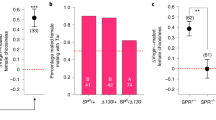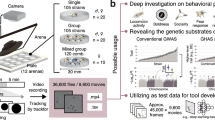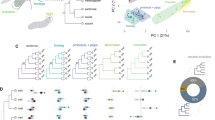Abstract
THE gene ‘antennaless’ of Drosophila melanogaster does not necessarily express itself fully in individuals homozygous for it1. In the course of a programme of work designed to isolate, by means of inbreeding and/or selection, a series of families all homozygous for this gene, but differing in degree of exhibition by reason of the various gene milieux present in the various families, it was noticed that high exhibition lines were conspicuously difficult to maintain. In view of the known chemoreceptive function of the antennæ in insects in general2 and in Drosophila in particular3, and the importance of the antennæ in the mating behaviour patterns of various species, experiments were started to see whether the poor results obtained with high exhibition lines could be ascribed to failure of adequate mating responses consequent upon absence of stimuli normally reaching the animal via these organs. Evidence that males were attracted to females by olfactory stimuli had not been obtained in previous experiments3.
This is a preview of subscription content, access via your institution
Access options
Subscribe to this journal
Receive 51 print issues and online access
$199.00 per year
only $3.90 per issue
Buy this article
- Purchase on SpringerLink
- Instant access to full article PDF
Prices may be subject to local taxes which are calculated during checkout
Similar content being viewed by others
References
Gordon, C., and Sang, J. H., Proc. Roy. Soc., B, 130, 151 (1941).
Marshall, J., Trans. Roy. Ent. Soc., 83, 49 (1935).
Begg, M., and Hogben, L., Proc. Roy. Soc., B, 133, 1 (1946).
Author information
Authors and Affiliations
Rights and permissions
About this article
Cite this article
BEGG, M., PACKMAN, E. Antennæ and Mating Behaviour in Drosophila melanogaster. Nature 168, 953 (1951). https://doi.org/10.1038/168953a0
Issue date:
DOI: https://doi.org/10.1038/168953a0



